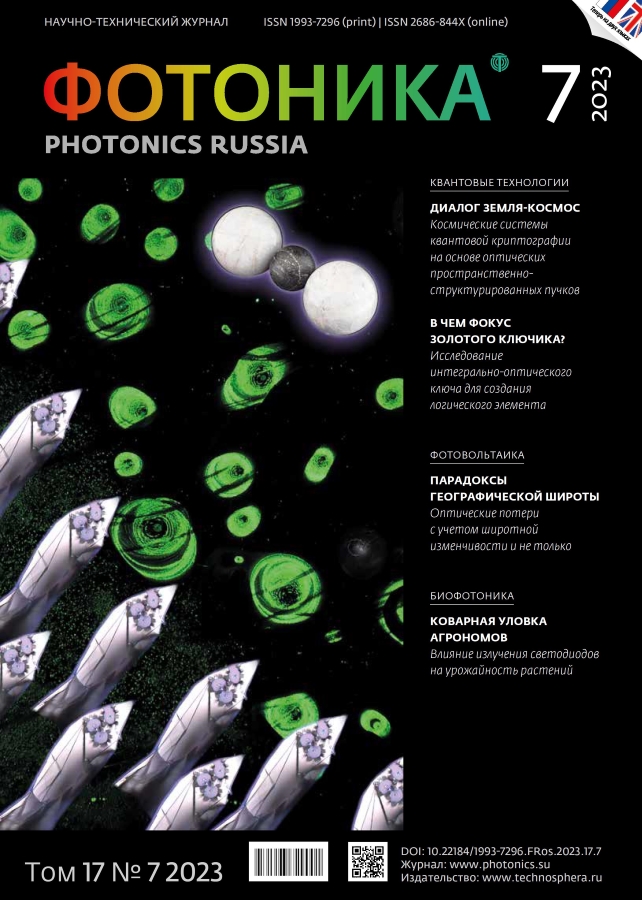Luminescence Nanothermometry by Single Organic Molecules: Manifestation of Electron-Phonon Interaction
- Authors: Savostianov A.O.1, Eremchev I.Y.2,3, Naumov A.V.1,3
-
Affiliations:
- Lebedev Physical Institute of the Russian Academy of Sciences Troitsk Branch
- Institute of spectroscopy RAS
- Moscow Pedagogical State University (MPGU)
- Issue: Vol 17, No 7 (2023)
- Pages: 508-514
- Section: Optical Measurements
- URL: https://journals.eco-vector.com/1993-7296/article/view/627916
- DOI: https://doi.org/10.22184/1993-7296.FRos.2023.17.7.508.514
- ID: 627916
Cite item
Abstract
Luminescent thermometry is a rapidly growing scientific method based on the dependence of the luminescent and spectral characteristics of nano-sized emitters on temperature. The accuracy of this method depends significantly on the theoretical models used to describe the temperature behavior of the spectra. In this paper, we provide a brief overview of our recent results related to new approaches to interpreting the temperature broadening of the spectral lines of single organic molecules in a polymer matrix as a result of electron-phonon interaction. We believe that the approach under consideration can be successfully applied to a variety of promising emitters used in luminescent thermometry.
Keywords
Full Text
About the authors
A. O. Savostianov
Lebedev Physical Institute of the Russian Academy of Sciences Troitsk Branch
Author for correspondence.
Email: journal@electronics.ru
ORCID iD: 0000-0001-8815-8440
Graduate student
Russian Federation, Moscow, Troitsk 108840I. Yu. Eremchev
Institute of spectroscopy RAS; Moscow Pedagogical State University (MPGU)
Email: journal@electronics.ru
ORCID iD: 0000-0002-2239-5176
Russian Federation, Troitsk, Moscow; Moscow
A. V. Naumov
Lebedev Physical Institute of the Russian Academy of Sciences Troitsk Branch; Moscow Pedagogical State University (MPGU)
Email: journal@electronics.ru
ORCID iD: 0000-0001-7938-9802
Russian Federation, Moscow, Troitsk 108840; Moscow
References
- G. Kucsko, P. C. Maurer, N. Y. Yao, M. Kubo, H. J. Noh, P. K. Lo, H. Park, and M. D. Lukin, Nanometre-Scale Thermometry in a Living Cell, Nature 500, 54 (2013).
- J. Zhou, B. del Rosal, D. Jaque, S. Uchiyama, and D. Jin, Advances and Challenges for Fluorescence Nanothermometry, Nat. Methods 17, 967 (2020).
- R. G. Geitenbeek, A.-E. Nieuwelink, T. S. Jacobs, B. B. V. Salzmann, J. Goetze, A. Meijerink, and B. M. Weckhuysen, In Situ Luminescence Thermometry To Locally Measure Temperature Gradients during Catalytic Reactions, ACS Catal. 8, 2397 (2018).
- C. Mi, J. Zhou, F. Wang, G. Lin, and D. Jin, Ultrasensitive Ratiometric Nanothermometer with Large Dynamic Range and Photostability, Chemistry of Materials 31, 9480 (2019).
- J. Qiao, X. Mu, and L. Qi, Construction of Fluorescent Polymeric Nano-Thermometers for Intracellular Temperature Imaging: A Review, Biosens. Bioelectron. 85, 403 (2016).
- L. Meng, S. Jiang, M. Song, F. Yan, W. Zhang, B. Xu, and W. Tian, TICT-Based Near-Infrared Ratiometric Organic Fluorescent Thermometer for Intracellular Temperature Sensing, ACS Appl. Mater. Interfaces 12, 26842 (2020).
- C. D. S. Brites, S. Balabhadra, and L. D. Carlos, Lanthanide-Based Thermometers: At the Cutting-Edge of Luminescence Thermometry, Adv. Opt. Mater 7, 1801239 (2019).
- L. Marciniak, K. Kniec, K. Elżbieciak-Piecka, K. Trejgis, J. Stefanska, and M. Dramićanin, Luminescencсe Thermometry with Transition Metal Ions. A Review, Coord. Chem. Rev. 469, 214671 (2022).
- S. Choi, V. N. Agafonov, V. A. Davydov, and T. Plakhotnik, Ultrasensitive All-Optical Thermometry Using Nanodiamonds with a High Concentration of Silicon-Vacancy Centers and Multiparametric Data Analysis, ACS Photonics 6, 1387 (2019).
- V. P. Dresvyansky, A. V. Kuznetsov, E. F. Martynovich, S. Enkbat, Monitoring the Heat of a Material during the Laser Formation of Defects // Bulletin of the Russian Academy of Sciences: Physics. – 2020. – Vol. 84, No. 7. – P. 811–814. – doi: 10.3103/S1062873820070084.
- А. И. Аржанов, А. О. Савостьянов, К. А. Магарян, К. Р. Кримуллин, А. В. Наумов, Фотоника полупроводниковых квантовых точек: прикладные аспекты // Фотоника. – 2022. – Т. 16, № 2. – С. 96–113. – doi: 10.22184/1993–7296.FRos.2022.16.2.96.112.
- L. J. Mohammed and K. M. Omer, Carbon Dots as New Generation Materials for Nanothermometer: Review, Nanoscale Res. Lett. 15, 182 (2020).
- M. D. Dramićanin, Trends in Luminescence Thermometry, J. Appl. Phys. 128, (2020).
- A. V. Naumov, Low Temperature Spectroscopy of Organic Molecules in Solid Matrices: From the Shpolsky Effect to the Laser Luminescent Spectromicroscopy for All Effectively Emitting Single Molecules, Physics Uspeckhi 183, 633 (2013).
- C. Gooijer, F. Ariese, and J. W. Hofstraat, editors, Shpol’skii Spectroscopy and Other Site-Selection Methods: Applications in Environmental Analysis, Bioanalytical Chemistry, and Chemical Physics (John Wiley & Sons, Hoboken, New Jersey, 2000).
- A. O. Savostianov, I. Y. Eremchev, T. V. Plakhotnik, and A. V. Naumov, The Key Role of Chromophore-Modified Vibrational Modes on Thermal Broadening of Single-Molecule Spectra in Disordered Solids, Phys. Rev. B to be published
- A. O. Savostianov, I. Y. Eremchev, T. V. Plakhotnik, A. S. Starukhin and A. V. Naumov, Manifestation of hybridization of intrinsic and induced resonant quasi-localized low-frequency vibrational modes of a polymer in low-temperature spectra of single impurity molecules, JETP Lett. to be published
- I. Yu. Eremchev, M. Yu. Eremchev, and A. V. Naumov, Multifunctional Far-Field Luminescence Nanoscope for Studying Single Molecules and Quantum Dots, Physics Uspekhi 189, 312 (2019).
- D. E. McCumber and M. D. Sturge, Linewidth and Temperature Shift of the R Lines in Ruby, J. Appl. Phys. 34, 1682 (1963).
- G. J. Small, Comment on Frequency Shift and Transverse Relaxation of Optical Transitions in Organic Solids, Chem. Phys. Lett. 57, (1978).
- I. S. Osad’ko, Optical Dephasing and Homogeneous Optical Bands in Crystals and Amorphous Solids: Dynamic and Stochastic Approaches, Phys. Rep. 206, 43 (1991).
- A. S. Barker and A. J. Sievers, Optical Studies of the Vibrational Properties of Disordered Solids, Rev. Mod. Phys. 47, (1975).
- L. Razinkovas, M. W. Doherty, N. B. Manson, C. G. Van de Walle, and A. Alkauskas, Vibrational and Vibronic Structure of Isolated Point Defects: The Nitrogen-Vacancy Center in Diamond, Phys. Rev. B 104, 045303 (2021).
- K. Sharman, O. Golami, S. C. Wein, H. Zadeh-Haghighi, C. G. Rocha, A. Kubanek, and C. Simon, A DFT Study of Electron–Phonon Interactions for the C2CN and VNNB Defects in Hexagonal Boron Nitride: Investigating the Role of the Transition Dipole Direction, Journal of Physics: Condensed Matter 35, 385701 (2023).
Supplementary files








